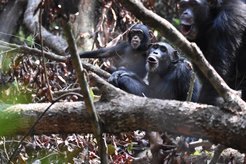Wild chimpanzees show capacity to combine meanings within utterances
New study reveals that wild chimpanzees use vocal sequences to denote a wide range of co-occurring or sequential daily events
Language enables humans to communicate about an infinite range of everyday events by combining a relatively limited set of sounds. In contrast, the ability of animals to string together calls to communicate about a wide range of events is seen as limited. Researchers from the Max Planck Institutes for Evolutionary Anthropology and for Cognitive and Brain Sciences in Leipzig, Germany, and the CNRS Institute for Cognitive Sciences in Lyon, France, recorded and analysed thousands of vocalisations from wild chimpanzees in Ivory Coast. The researchers observed that when chimpanzees were engaged in a single event (like eat, play, rest, greet), they were likely to emit a single call. However, when engaged in more than one event at a time (like eat and greet, travel and meet) chimpanzees were twice as likely to use vocal sequences than single calls. Also, chimpanzees who engaged in a wider range of events produced more diverse vocal sequences. These new results suggest that chimpanzees possess crucial prerequisites for the evolution of compound communication.

Humans flexibly combine meaningful words into hierarchically structured sequences to communicate about an extensive range of everyday events. This compound communication allows us to flexibly express any message using only a limited set of sounds. The ability of animals to string calls into diverse vocal sequences to communicate about a wide range of events has not yet been demonstrated and the evolution of such a compound communication remains an enigma.
Comparing communication systems of animals to that of humans is a way to help solve this riddle. If there is an advantage in conveying information about numerous daily events, especially when they occur juxtaposed in time, then natural selection should favour the production of vocal sequences over single calls. However, while many species experience more than one event at a time, few are documented to produce vocal sequences in response to them. Moreover, examples per species are usually few, short (consisting of two unit-sequences), and mostly associated with alarm events. Whether this reflects true limitations in animal communication, or rather reflects the difficulties of conducting this type of research (which is very time consuming) remains to be seen.
Researchers recorded thousands of vocalisations from 98 wild chimpanzees living in the Taï National Park in Ivory Coast. They studied chimpanzees of all ages, from newborn to old (55 years old). Researchers identified 13 different calls that were combined into hundreds of vocal sequences of varying lengths. Tatiana Bortolato, the lead author of this study, emphasized, “Analysing the entire repertoire of one of our closest living relatives is uncommon but crucial for understanding the general combinatorial patterns of the species - and for tracing the evolutionary origins of human language”.
Vocal sequences and their behavioural and environmental context
Additionally, researchers collected comprehensive behavioural and environmental data to discern the events that elicited each vocal sequence. Roman Wittig and Cedric Girard-Buttoz, senior authors of the study, concur, “While most animals routinely encounter multiple simultaneous or sequential events in their daily life, such as greeting in a food patch or an approach followed by affiliation, the vast majority will only use a single call in such a situation. This suggests that the capacity to use vocal sequences to communicate combined information in a wide diversity of situations may be rare in the animal kingdom, but many animal communication systems remain to be fully understood”.
“While we do not address syntax in this study, the production of numerous and long vocal sequences to convey numerous messages about daily events likely constitutes a precondition from which human communication could have evolved”, senior author Catherine Crockford added. “Communicating about two or more concomitant events in the present offers one evolutionary scenario from which the capacity to communicate about concomitant events in the past or future may have emerged, such as in humans”, recalls Bortolato.
In the next step, the authors plan to complement this study by identifying the information conveyed by these vocal sequences and assess whether the use of vocal sequences expands the communication potential of chimpanzees to manage their complex social life.












